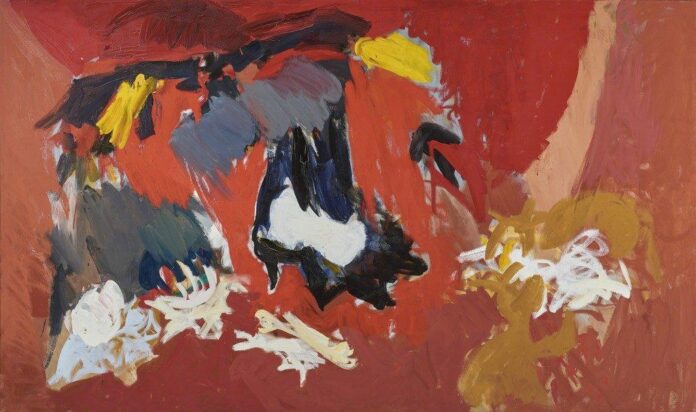It’s been 30 years since Ethel Schwabacher had a proper solo show in New York City. But in the 1950s, she was at the forefront of the Abstract Expressionist movement, showing vibrant canvases with bold colors, fluid brushstrokes, and even snippets of poems at the Betty Parsons Gallery in New York.
“Ethel was a poet as well, so she would put lines of her poetry in her paintings—which for the 1950s was way ahead of its time,” Christine Berry, cofounder of New York’s Berry Campbell Gallery, told Artnet News.
Now, the late artist—who has work in the collections of institutions including the Los Angeles County Museum of Art, Philadelphia Museum of Art, and the Solomon R. Guggenheim Museum, Whitney Museum of American Art, and Metropolitan Museum of Art in New York—is having enjoying a well-deserved revival at Berry Campbell.
At the Chelsea gallery, a nearly sold-out exhibition is on view through this weekend. The works, priced at $165,000 to $400,000—far above the artist’s auction record of $56,250, set in 2020, according to the Artnet Price Database—focuses on the artist’s works from the 1950s.

Ethel Schwabacher, (1955). Courtesy of Berry Campbell, New York.
For decades, the Schwabacher estate was represented by Anita Shapolsky Gallery, an elderly dealer on the Upper East Side who stages about three shows a year out of her townhouse.
The past few years have been a moment of rediscovery for many other women of the Ab Ex movement, with the acclaimed Mary Gabriel book , and in the landmark 2016 Denver Art Museum show “Women of Abstract Expressionism.” But it seemed as though Schwabacher—one of the 12 artists in the Denver show—might be left behind.
Enter Berry Campbell, which also represents the estates of Judith Godwin and Perle Fine, two of the other women in the Denver show.
When the dealers got in touch with the artist’s son, lawyer Christopher Schwabacher (who for years represented Parsons), they were shocked if delighted to discover hundreds of paintings, not seen for decades, carefully packed away in storage. That included the show’s centerpiece, , a 1959 canvas that had to be unrolled and stretched for the occasion.

Ethel Schwabacher, (1959). Courtesy of Berry Campbell, New York.
“These all have Betty Parsons labels on the back,” Berry said. “It’s incredible.”
The artist continued painting until her death in 1984, and the dealers hope to build an appreciation of Schwabacher’s oeuvre with a series of shows spanning her entire career.
“Originally, we thought we would have to do a retrospective since no one knew who she was—but the paintings were so strong,” gallery cofounder Martha Campbell added.
When Artnet News visited “Ethel Schwabacher: Woman in Nature (Paintings from the 1950s),” it was a busy afternoon.

Ethel Schwabacher (ca. 1955). Courtesy of Berry Campbell, New York.
Christopher Schwabacher and his wife, Hannelore, had stopped by to visit, and there were repair men in the space—a construction project next door had dropped an anvil on the gallery skylight, causing pane of glass to shatter. Thankfully, no one was hurt, and the paintings were not damaged.
Christopher Schwabacher, now age 81, was unfazed by the incident, and happy to share childhood memories of his mother painting—a widow, she would put on classical music to drown out the noise of him playing with his sister, Brenda Webster, while she worked. The living room was pressed into service as an art studio.
“I’ve never seen so many paint tubes of paint. As kids we were fascinated by them,” Christopher Schwabacher told Artnet News. “When we could sort of let loose and not be so careful was when she would bring her brushes out to the faucet in the pantry to wash them.”
Decades later, the artist’s son is hopeful the time is ripe for a reappraisal of Schwabacher’s career—and he sees the skylight incident as a good omen: “We have a smashing success right here!”
See more paintings from the show below.

Ethel Schwabacher, (1958). Courtesy Berry Campbell, New York.

Ethel Schwabacher, (1957). Courtesy of Berry Campbell, New York.

Ethel Schwabacher, (1957). Courtesy of Berry Campbell, New York.

Ethel Schwabacher, (1957). Courtesy of Berry Campbell, New York.

Ethel Schwabacher, Return and Departure (1956). Courtesy of Berry Campbell, New York.

























